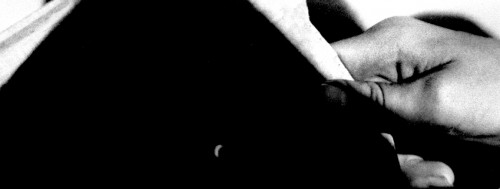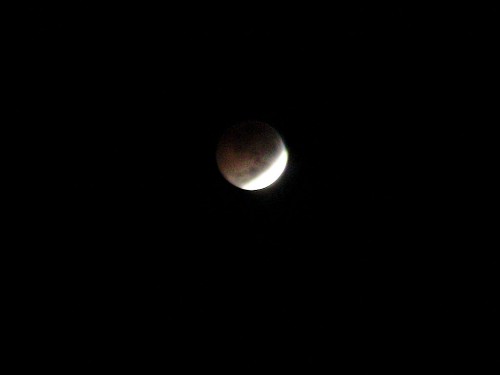The negative sleeve read “Eclipse,” but I couldn’t figure out what the picture was showing. Then it dawned on me (no pun intended): you don’t point your camera directly at the sun unless you have heavy-duty filters in place. The way we were told to shoot the eclipse was to cut a pinhole in a piece of cardboard and use that to project the sun’s image onto another surface. (Click on it to make it larger.)
(I always took warnings seriously. When we got our first-ever Associated Press Laserphoto machine, I put up a sign on the inside that said, “Do Not Look at the Laser Beam with Your Remaining Eye.)
That tiny crescent of light toward the bottom of the picture was as good as it got. We didn’t have a total eclipse in Cape, so the whole sun wasn’t blocked out.
In trying to track down a date for the eclipse, I found a wire story headlined “Lucky Old Sun Stars in Show” on the front page of the Missourian on July 20, 1963.
The next day’s paper had a close-up of a crescent similar to mine. I was doing some freelancing for them by then, but I don’t think it was mine.
Tucker execution dominated news
The news that week was dominated by the pending execution of Sammy Aire Tucker for the murder of Cape Girardeau policeman Donald H. Crittendon on March 10, 1961. Auxiliary officer Herbert L. Goss also died in the shootout. A memorial for them is on the Common Pleas Courthouse grounds.
The Missourian headline on July 26 was In Puff of Poison Gas: Tucker Meets Death Quietly.
Lunar eclipse in Florida
That Cape solar eclipse sort of dampened my enthusiasm for eclipses, but I did shoot a total lunar eclipse in Florida in 2010. I have to admit that Terry Hopkins had the best idea:
- Go out in the back yard and stare at the full moon.
- Close your eyes.
- Open your eyes.
- Go to bed
- Complain about how hard it is to get up



Ugh. What an excruciatingly detailed account of the execution process. Perhaps better if we focus on the two police officers whose lives were lost:
Patrolman Donald Henry Crittendon, who’d submitted his resignation to accept another position. That resignation would have become effective at 11pm the night he was shot.
http://www.odmp.org/officer/3626-patrolman-donald-harold-crittendon
Auxilliary Officer (volunteer) who’d retired from the Cape G. Street Dept. two years earlier:
http://www.odmp.org/officer/5602-auxiliary-sergeant-herbert-l-goss
Thanks for the links. Sorry for the delay in approving them. The spam filter holds any comment with two or more links for moderation, so it didn’t post right away.
Your point is well taken. I posted the execution links because they were the stories that ran at the same time as the eclipse story. It wasn’t intended to be the definitive piece on that tragic night and all of the participants.
Sorry, I didn’t mean to complain at you for posting that. Journalist/genealogist wannabe here. I just decided to find out more about that shooting and make the info available to your readers. Also, some readers may be able to recall that story from their childhood/youth.
No offense taken. I debated whether or not to expand on the events of that tragic night, but figured readers would chime in like they did, much to my surprise, when I did a story on Wimpy’s.
Good advise then and good advise now….
That Cape solar eclipse sort of dampened my enthusiasm for eclipses, but I did shoot a in 2010. I have to admit that Terry Hopkins had the best idea:
Go out in the back yard and stare at the full moon.
Close your eyes.
Open your eyes.
Go to bed
Complain about how hard it is to get up